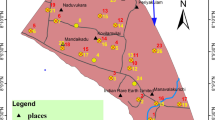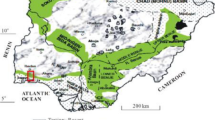Abstract
Landsat-7 EMT+ and ASTER GDEM images of Ejigbo area, Osun State Nigeria were processed to generate composite lineament map and lineament-intersection map. Thirty-two Schlumberger vertical electrical sounding (VES) data set were quantitatively interpreted to determine aquifer resistivities and aquifer thicknesses in the area. The lineament density ranged between 0 and 5.52 km/km2. Thematic maps of the geology, the lineament density, the lineament-intersection density, the aquifer thickness and the aquifer resistivity of the study area were integrated to classify the area into varied groundwater potential zones. The study concluded that the groundwater potential of areas around Ejigbo, Osun state is of poor to moderate level rating.


Adapted from Nigeria Geological Survey Agency Iwo Sheet II (2006)











Similar content being viewed by others
References
Abdullah, A., Nassr, S. and Ghaleeb, A., 2013. Landsat ETM-7 for lineament mapping using automatic extraction technique in the SW part of Taiz area, Yemen, version 1.0. Glob J Hum Soc Sci Geogr Geo-Sci Environ Disaster Manag 13(3):35–38
Abdullahi BU, Rai JK, Momoh M, Udensi EE (2013) Effect of lineaments on groundwater occurrence. Int J Environ Bioenergy 8(1):22–32
Akinluyi FO (2013) Integration of remotely sensed and geophysical data in groundwater potential evaluation of the basement complex terrain of Ondo state, Southwestern Nigeria. Ph.D. Thesis. Obafemi Awolowo University, Ile-Ife
Amin S (2008) Identification of groundwater storage and flow through the analysis of fracture systems from space. In: 3rd international conference on water resources and arid environments and the 1st Arab water forum, Lebanese National Council for Scientific Research, Remote Sensing Center, Beirut
Anudu GK, Essien BI, Onuba LN, Ikpokonte AE (2011) Lineament analysis and interpretation for assessment of groundwater potential of Wamba and adjoining areas, Nasarawa state, Northcentral Nigeria. J Appl Technol Environ Sanit 1(2):185–198
Ariyibi EA (2008) Geophysical investigation for the delineation of potential mineralized zones in the area around Ilesha, Southwestern Nigeria. Ph.D. thesis. Department of Applied Geophysics, Federal University of Technology, Akure
Ariyibi EA (2011) Integrated geochemical and geophysical approach to mineral prospecting. A case study on the basement complex of Ilesha Area. InTech, Rijeka, Nigeria, pp 71–92
Edet AE, Okereke CS, Teme SC, Esu EO (1998) Application of remote-sensing data to groundwater exploration: a case study of the Cross River state, Southeastern Nigeria. Hydrogeol J 6:394–404
Ekwe AC, Nnodu IN, Ugwumbah KI, Onwuka OS (2010) Estimation of aquifer hydraulic characteristics of low permeability formation from geosounding data: a case study of Oduma town, Enugu state. Online J Earth Sci 4(1):19–26
ESRI (2012) ArcMap 10.1 help menu. ESRI Inc, California
Fetter C (2001) Applied hydrogeology. 4th edn. Prentice Hall, Upper Saddle River
Greenbaum D (1985) Review of remote sensing applications to groundwater exploration in basement and regolith. Brit Geol Surv Rep OD 85/8:36
Haridas VR, Chandra Sekaran VA, Kamaraswany K, Rajendran S, Unnikrshman K (1994) Geomorphological and lineament studies of Kanjamala using IRS-A data with special reference to groundwater potentiality. Trans Inst Indian Geogr 16(1):35–41
ITC (2005) ILWIS 3.3 academic user’s guide. International Institute for Aerospace Survey and Earth Sciences, Enschede
Kiran RS, Ahmed SA (2014) Lineament extraction from Southern Chitradurga Schist belt using Landsat TM, ASTERGDEM and geomatics techniques. Int J Comput Appl 93(12):975–8887
Mallast U, Gloaguen R, Geyer S, Rodiger T, Siebert C (2011) Derivation of groundwater flow-paths based on semi-automatic extraction of lineaments from remote sensing data. Hydrol Earth Syst Sci 15:2665–2678. doi:10.5194/hess-15-2665-2011
McDonald AM, Bonsor HC, Calow RC, Taylor RG, Lapworth DJ, Maurice L, Tucker J, Ó Dochartaigh BÉ (2011) Groundwater resilience to climate change in Africa. Br Geol Survey Open Rep OR/11/031: 1–25
Odeyemi IB, Anifowose YB, Asiwaju-Bello YA (1999) Multi-technique graphical analyses of fractures from remote sensing images of basement regions of Nigeria. J Min Geol 33(1):9–12
Olorunfemi MO, Fasuyi SA (1993) Aquifer types and the geoelectric/hydrogeologic characteristics of part of the central basement terrain of Nigeria (Niger state). J Afr Earth 16(3):309–317
Oloruniwo MA, Olorunfemi MO (1987) Geophysical investigation for groundwater in Precambrian terrains: a case study from Ikare. Southwestern Nigeria. J Afr Earth Sci 6(6):787–796
PCI Geomatica (2001) PCI Geomatica user’s guide version 9.1. PCI Geomatica, Richmond Hill
PCI Geomatica (2014) PCI Geomatica user’s guide. PCI Geomatica, Richmond Hill
Rahaman, M.A., 1976. Review of the basement geology of southwestern Nigeria. In: Kogbe CA (ed) Geology of Nigeria. Elizabethan Publishing Company, Lagos, pp 41–56
Sander P (2007) Lineaments in groundwater exploration: a review of applications and limitations. Hydrogeol J 15:71–74
Shahid S, Nath SK (2002) GIS integration of remote sensing and electrical sounding data for hydrogeological exploration. J Spat Hydrol 2(1):1–12
Srivastava VK, Devendra NG, Pawan B (2012) Study and mapping of ground water prospect using remote sensing, GIS and geoelectrical resistivity techniques—a case study of Dhanbad district, Jharkhand, India. J Ind Geophys Union 16(2):55–63
Yenne EY, Anifowose AYB, Dibal HU, Nimchak RN (2015) An assessment of the relationship between lineament and groundwater productivity in a part of the basement complex, Southwestern Nigeria. IOSR J Environ Sci Toxicol Food Technol (IOSR-JESTFT) 9(6 Ver. I):23–35
Acknowledgements
The authors express their profound gratitude to Prof. M. O. Olorunfemi of Department of Geology, Obafemi Awolowo University, Ile-Ife for his constructive criticism and review of this work.
Funding
This research did not receive any specific Grant from funding agencies in the public, commercial, or not-for-profit sectors.
Author information
Authors and Affiliations
Corresponding author
Rights and permissions
About this article
Cite this article
Dasho, O.A., Ariyibi, E.A., Akinluyi, F.O. et al. Application of satellite remote sensing to groundwater potential modeling in Ejigbo area, Southwestern Nigeria. Model. Earth Syst. Environ. 3, 615–633 (2017). https://doi.org/10.1007/s40808-017-0322-z
Received:
Accepted:
Published:
Issue Date:
DOI: https://doi.org/10.1007/s40808-017-0322-z




